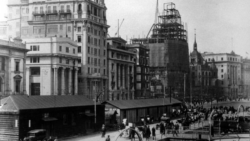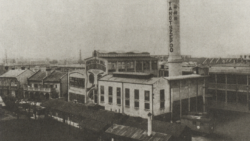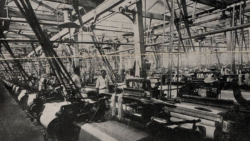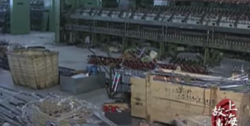Shanghai Textile Industry, China's Mother industry
The textile industry is widely regarded as China’s Mother Industry, its’ development in Shanghai landmarking China’s industrial revolution.
The transformation of Shanghai from a fishing village into an urban city began in the mid-1800s. Since the 1700s the Qing government had allowed western access to just one Chinese port and, from Gaungzhou, the west traded for tea, porcelain and silk in exchange for silver. As silver became a rarer commodity, due to increased wealth in the UK following the Industrial Revolution, and a greater desire amongst the general population to retain precious metals, the British began importing Opium to China from its farms in India. This caused concerns within the Qing government who outlawed the trade, threatening the death penalty on all involved, instigating the first ‘Opium War’. The Chinese suffered a humiliating defeat at the hands of the British navy, as a result of which, China was forced to cede Hong Kong to British rule and open five mainland ‘Treaty Ports’ to western traders under the 1842 Treaty of Nanjing. Shanghai was one of the Treaty Ports and the Westerners immediately began to construct their own settlements and introduce their modern technologies, especially new textile machinery developed during the UK’s Industrial Revolution. Merchants from France, Germany, the US and other western nations took footholds in Shanghai, developing foreign ‘concessions’ in which they were exempt from Chinese laws.

The Bund under construction - image 'Virtual Shanghai'
The British ‘concession’ was established in 1845, the US in 1848 and the French in 1849.
As opium continued to be imported there was civil unrest across China leading to the second Opium War, in which British and French troops inflicted further humiliation on the Qing when they marched on Peking, occupying the city for a week and looting the Summer Palace. A further treaty in 1860, The Treaty of Tientsin, ceded further territories to the west and legalized the sale of opium.
In 1888, Li Hongzhang, leading reformer of the Qing court (1644-1911) established the first Chinese mill, the Shanghai Machine Weaving Bureau, but it was destroyed in 1891 by a fire. In 1893, from the burnt ashes of the previous mill, Li built the New Cotton Spinning and Weaving Bureau, which employed about sixty technicians and three hundred workers. Three other cotton mills were also built in Shanghai and by 1894, the development of silk filatures and cotton mills, as well as shipbuilding, machine-repair, and other industrial sites, made Shanghai the largest industrial centre in China, with more than 36,000 factory workers (Honig 1986: 16).

Jardine and Mathesons EWO Mill at Yangztepoo Image - 'Virtual Shanghai'
It was not until the end of the Sino-Japanese War, and the signing in 1895 of the Treaty of Shimonoseki, that foreigners were granted the right to build their own factories in the treaty ports and the British were the first to take advantage of the newly won privilege for foreigners in China. The largest British mills in Shanghai, the Yi He and the Lao Gong Mou mills, were established by Jardine and Matheson in 1895 and 1896, respectively (Gamewell 1916: 223). Two other British mills were established in 1895, The Oriental Mill owned by the Arnhold Bros. and the Laou Kung Mow owned by Ilbert and Co. A locally produced cotton supply was soon insufficient to feed the new Shanghai mills and raw cotton from India was diverted from the UK, where rising wages and living standards had raised production costs, directly to Shanghai. The textile industry continued to expand through other western nations, particularly Japan. The Japanese opened one spinning mill in Shanghai in 1895 on Yangtzsepoo Road and another in 1896. The main development of Japanese Spinning Mills in Shanghai commenced from 1908 and by 1922 there were twenty-four Japanese mills operating around 603,376 spindles. By this time, along with the western owned factories, there were estimated to be eighty Chinese owned spinning Mills in Shanghai, compared to only seventy throughout the rest of China, making Shanghai the undisputed centre of China’s textile industry.

Inside Textile Factory - Image 'Virtual Shanghai'
The main focal point of textile factory development was the Western area of the International Settlement, along the bank of the Suzhou Creek. The creek had been cleaned and redeveloped by the international community and provided waterway transportation for the developing industries. Initial steam-powered machinery quickly gave way to more modern production methods as power plants at Yantzsepoo, along with privately established electricity generators across the district, ran increasing numbers of spinning machines.
Increasing conflict between China and Japan lead to the ‘Battle of Shanghai’ in 1932 in which Japanese naval ships inflicted severe damage to the city, although by agreement the International Settlements were left untouched. However, the Battle of Shanghai in 1937 saw significant damage to the textile factories throughout Shanghai with 136 textile factories within the International Settlement destroyed whilst Chinese owned factories outside the International Settlement, which had survived the 1932 battle, had further damage inflicted as 22 woollen factories, 31 Cotton Spinning factories, 112 Silk Reeling factories and 6 Dyeing factories were destroyed. The ‘Isolated Island’ period commenced with Japan controlling all parts of Shanghai around the International Settlement and controlling the supply of materials and supplies to the International Settlement – non-Japanese factories struggled for materials. Japan entered the Second World War and overran the whole of Shanghai in 1939, assuming control of all industrial enterprises and all westerners who had not previously evacuated were interned in prison camps for the duration of the war.
When Japan finally surrendered, in 1945, the Chinese once again took control of Shanghai and western businesses were returned to their owners. Shanghai’s textile industry recovered rapidly. However, as civil war continued across China, there was increasing concern at the prospect of the Chinese Communist Party taking power, and by 1949, when Mao Zedong formally announced the liberation of China and the formation of the Peoples Republic, many Shanghai businesses had already departed, many taking as much of their equipment as they could salvage with them, to nearby Hong Kong, where a new textile industry was hastily developed.

Image - Shanghai Story 2014
The first PRC five year plan was focused on Industrialization and Modernization. Major infrastructure building of national industries and cultural institutions took place and, under a centralized economy, the Shanghai textile industry expanded as State Owned Enterprises. Taxes and incomes raised from Shanghai’s industry supported socio-political developments across the rest of China throughout the years of revolution and reform under the leadership of Mao, leading to Shanghai being referred to as China’s ‘Cash Cow’. However, following Mao’s death, under the urban marketization processes instigated in 1984, private companies began to appear across the country. Various town and village-based textile enterprises sprang up equipped with the latest machines and technology, whilst in the State Owned Shanghai textile factories, machines were becoming out dated and technologies were lagging far behind.
In response to Deng Xiaoping’s 1992 Southern Tour, Shanghai began its’ industry to post-industry transition, focusing on State-Owned Enterprise (SOE) reform and developing a new service industry. Premier Zhu Rongji proposed ‘smashing ten million (old) machines nationally (quanguo yading yibaiwan)’. Shanghai No. 22 Textile factory, the very first China textile factory built by Li Hongzhang, was the first textile factory to hammer the machines. This was the beginning of Shanghai’s transition from the nations’

Image - Shanghai Story 2014
industrial heart to the new service industry focused, international trading and financial centre, leading the way to a global economic surge through which it became widely known as ‘The Head of The Dragon’.
By 2000, the Shanghai service economy composed 50% of the total city industry. With workers being laid off entirely and factories closed and demolished, some sites were saved to preserve industrial heritage and began to reopen as Shanghai’s creative clusters – models of urban regeneration and design of post-industrial cultural and creative industries. By 2004, the “third industry” accounted for approximately 6% of Shanghai’s GDP, employing nearly half a million people in major cultural institutions. It reflected the ambition of China to join the “global creative economy” and become “a significant exporter of cultural goods and services rather than simply a low-cost location for manufacturing” (Keane 2004).
In 2005, led by the Shanghai economic committee (Shanghai Shijinwei), the Shanghai creative economy development bureau was set up, aiming at attracting business in industrial design, gaming software, digital media and fashion, as well as creative clusters established to assist Shanghai economic transition. By 2007, there were 70 to 80 creative clusters. The long-term aim was to establish Shanghai as the most influential creative industry centre in Asia in 10 to 15 years and to lead creative industries globally within 25 years (Zhu 2007: 139). The 16th Plenary Session of the seventeenth Communist Party of China Central Committee in 2011 stressed China’s transformation from ‘Made in China’ to ‘Created in China’ (McCarthy and Wang 2016:6).
Today, China maintains a vast textile industry, though not in Shanghai where bespoke textile production is focused upon new and exciting fashions and technologies, including the development of material requirements for Chinas’ expanding space exploration programme. Selected factories were fortunate to avoid demolition, under urban regeneration planning and remain as heritage sites, hosting museums or creative arts clusters. The Shanghai Textile Museum proudly stands on the site of Li Hongzhangs’ first Shanghai textile factory and the M50 Creative Arts Cluster occupies the buildings which were once the Xinhe Cotton Mill. However, like the three factories that were demolished to make way for the triangular base of the new city landmark, the Oriental Pearl Tower, most factory sites in Shanghai were destroyed for new development initiatives, leaving little visible evidence of what was the original driving force behind Shanghai’s rise to national and international prominence. As the Curator of the Shanghai Textile Museum states: “If we did not dismantle the factories, we could not redesign the city. For Shanghai’s post-industrial economic rise, our textile industry sacrificed herself’ (Jiang, 2020).
To use the above information please quote the following:
Ma H 2021. Song of the Female Textile Workers: UK-China Digital Creativity, funded by UK Arts and Humanities Research Council. https://bridgingthegaps.leeds.ac.uk/ Access date
Reference:
Gamewell, M.N., 1916. The Gateway to China: Pictures of Shanghai. Quaker City Books.
Honig, E.S., 1986. Strangers: Women in the Shanghai Cotton Mills, 1919–1949. Stanford: Stanford University Press.
Jiang G. 2020. A Curator's Introduction to Global Performance and Cultural Industries Master's class, from Shanghai Textile Industry Museum. 20th November 2020.
Keane, M., 2004. Brave new world: Understanding China’s creative vision. International Journal of Cultural Policy, 10(3), pp.265-279.
Ma H. Forthcoming. The Missing ICH in Shanghai CCI. International Journal of Cultural Policy.
Ma H. 2015, Urban Policy and Cultural Capital, the case of Chinese opera. London: Routledge.
McCarthy, J. and Wang, Y., 2016. Culture, creativity and commerce: trajectories and tensions in the case of Beijing's 798 Art Zone. International planning studies, 21(1), pp.1-15.
Zhu J. 2007. Shanghai City and Creative Cluster development research (Zhongguo chengshi yu shanghai chanye yuanqu xietiao fazhan yanjiu). China population resources and environment (Zhongguo renkou ziyuan yu huanjing). 17(6), pp.139-142.
